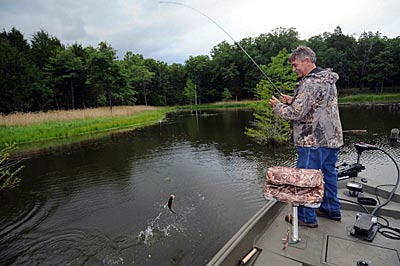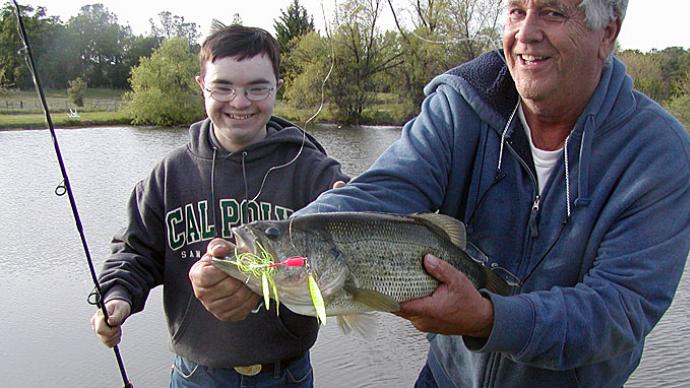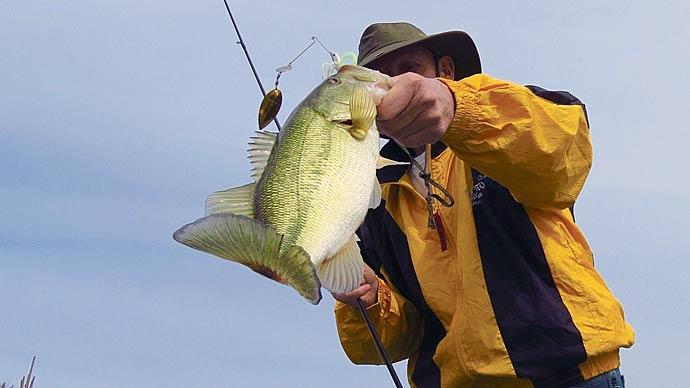
As darkness crept in, I cast my 1/4-ounce spinnerbait to a weed line and turned the reel handle several times. When I felt a hard pull on the line, I set the hook, and a hefty bass leaped out of the water in an attempt to throw my spinnerbait.
The fish made a couple of solid runs, but I eventually wore it down and lipped the 5-pounder into the boat. My partner, Jack Davis, had also caught a 5-pounder earlier that evening on a small square bill crankbait, and we had caught numerous smaller bass throughout the afternoon and evening. Our fishing trip that day on a private pond was the perfect summer vacation away from the hustle and bustle of pleasure boats, water skiers, and jet skis we encounter on the big reservoirs.
Fishing a pond is a great way to catch numbers of bass and big fish if you can find the right pond. A pond needs the right ingredients to produce big bass, according to Jimmy Duncan, the owner of the pond Davis and I fished. Duncan has constructed his 12-acre pond with plenty of habitat and managed its fish populations to grow lunker bass in his private fishery.
Duncan suggests a good pond for bass fishing should have reasonably clear water and some aquatic vegetation and brush piles that provide cover for bass. The pond should also have more shallow water than deep water. “In the summertime, ponds kind of stratify so the fish are not going to be any deeper than 5 or 6 feet,” Duncan says. So summertime bass in a pond will either be holding along the shoreline in less than 5 feet of water or suspended 5 feet deep in the middle of the pond.
The pond owner manages his fishery by ensuring the pond has the right balance of bass and bluegill. His pond contains water willows and brush piles that cover the bluegill, so smaller bass don’t eat all the forage. This practice allows the bluegill to reach 5 inches or longer for bass in the 4- to 8-pound range to eat. Duncan also takes out several 12-inch or smaller bass throughout the year to prevent the bass population from becoming stunted. ‘The pond is only going to support X amount of pounds of fish whether you have ten 10-pounders or one hundred 1-pounders,” Duncan says.
“The pond will also support more fish the more fertile it is,” Duncan says. “So a pond can be fertilized, increasing the whole food chain starting from the algae up.”
Duncan also feeds his fish to improve his pond's fish populations. “It makes the bluegill a lot healthier, and they spawn better, increasing the food for the bass,” Duncan says.
Fishing a pond has its advantages over fishing a large reservoir for bass. Duncan notes bass are easier to find on a pond because you have less water to cover than in a vast lake. You can also have as much success fishing from the bank as fishing from a boat on a farm pond, whereas a boat is frequently needed to catch big water bass. Private ponds also receive less fishing pressure than the public reservoirs, so pond bass are less spooky and lure-shy.

Duncan can catch bass from his pond throughout the day in the summertime, but he prefers fishing in the mornings and evenings when bass move shallower to feed on the bluegill. The Missouri angler relies on the same lures he throws on larger reservoirs but downsizes his baits. Throwing smaller baits helps him catch the smaller fish to thin out the bass population. “You will still catch good fish doing that, too,” Duncan said.
Good lures for catching pond bass in the summertime include spinnerbaits, crankbaits, topwater lures, plastic lizards, plastic worms, and Senkos. Duncan’s favorite topwater lures are a buzz bait and a Zoom Horny Toad. He favors a Bomber 2A crankbait in a crawfish hue or chartreuse to imitate bluegill. If a pond has moss or grass, Duncan recommends throwing a shallow-diving crankbait such as a Mann’s Baby 1-Minus to keep the lure running above the weeds.
Duncan throws all his lures on a baitcast reel filled with 15-pound test line. He uses a 7 1/2–foot flipping stick for his plastic lizards and medium-heavy casting rods for the rest of his pond lures.
Getting to fish a private pond is a special privilege for anglers willing to respect the owner’s property. “I have never had a problem with somebody who wants to fish if I am here,” Duncan says. He suggests you avoid making ruts when driving in the property owner’s field and never leave trash behind if you want to fish the owner’s pond again. Duncan also advises you should take bass out of the pond at the owner’s request—even if you think it is sacrilegious to keep bass.
BassResource may receive a portion of revenues if you make a purchase using a link above.




